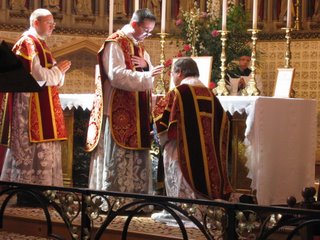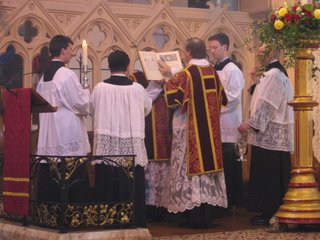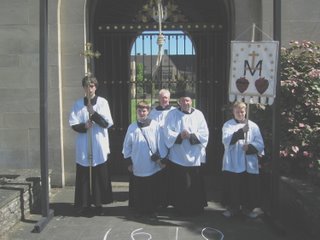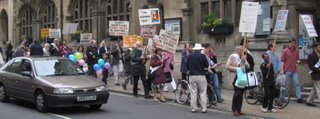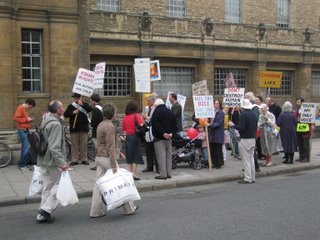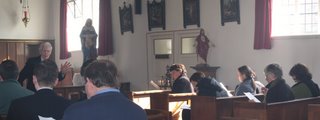In response to continuing confusion over whether the Traditional Mass should be allowed only as an exception, in special circumstances, I have put together some quotations on the subject from authoritative sources.
Ecclesia Dei Adflicta, John Paul II, 1988:To all those Catholic faithful who feel attached to some previous liturgical and disciplinary forms of the Latin tradition, I wish to manifest my will to facilitate their ecclesial communion by means of the necessary measures to guarantee respect for their rightful aspirations. In this matter I ask for the support of the bishops and of all those engaged in the pastoral ministry in the church.
...
Moreover, respect must everywhere by shown for the feelings of all those who are attached to the Latin liturgical tradition by a wide and generous application of the directives already issued some time ago by the Apostolic See for the use of the Roman Missal according to the typical edition of 1962.
---------------
Letter from Cardinal Mayer to the Bishops of the US: (1990)Consequently, Your Excellency, we wish to encourage you to facilitate the proper and reverent celebration of the liturgical rites according to the Roman Missal of 1962 wherever there is a genuine desire for this on the part of the priests and faithful. This should not be construed as a promotion of that Missal in prejudice to the one promulgated eight years later, but simply a pastoral provision to meet the "rightful aspirations" of those who wish to worship according to the Latin liturgical tradition as celebrated for centuries.
--------------------------
Cardinal Stikler, commenting on the report made by the 1986 commission of cardinals to John Paul II on the legal status of the Traditional Mass, (May 20, 1995 at the
Christi Fidelis conference in Fort Lee, New Jersey, USA):
"I can answer because I was one of the Cardinals." He continued, "the answers given by the nine Cardinals in 1986 was 'No, the Mass of Saint Pius V has never been suppressed'."
"the nine Cardinals unanimously agreed that no bishop may forbid a Catholic priest from saying the Tridentine Mass."
---------------------------
Cardinal Ratzinger, A lecture given at the Ergife Palace Hotel, Rome on Saturday 24th October 1998. It is good to recall here what Cardinal Newman observed, that the Church, throughout her history, has never abolished nor forbidden orthodox liturgical forms, which would be quite alien to the Spirit of the Church. ... The authority of the Church has the power to define and limit the use of such rites in different historical situations, but she never just purely and simply forbids them! Thus the Council ordered a reform of the liturgical books, but it did not prohibit the former books.
...
We must now examine the other argument, which claims that the existence of the two rites can damage unity. Here a distinction must be made between the theological aspect and the practical aspect of the question. As regards what is theoretical and basic, it must be stated that several forms of the Latin rite have always existed, and were only slowly withdrawn, as a result of the coming together of the different parts of Europe. Before the Council there existed side by side with the Roman rite, the Ambrosian rite, the Mozarabic rite of Toledo, the rite of Braga, the Carthusian rite, the Carmelite rite, and best known of all, the Dominican rite, and perhaps still other rites of which I am not aware. No one was ever scandalized that the Dominicans, often present in our parishes, did not celebrate like diocesan priests but had their own rite. We did not have any doubt that their rite was as Catholic as the Roman rite, and we were proud of the richness inherent in these various traditions. Moreover, one must say this: that the freedom which the new order of Mass gives to creativity is often taken to excessive lengths. The difference between the liturgy according to the new books, how it is actually practiced and celebrated in different places, is often greater than the difference between an old Mass and a new Mass, when both these are celebrated according to the prescribed liturgical books.
-----------
Cardinal Castrillon Hoyos, interview with the Latin Mass Magazine: (May 2004)...this celebration [at Mary Major] has reassured many of the faithful that the venerable Rite of St Pius V, which in enjoys in the Latin Rite of the Catholic Church a "right of citizenship", as I said in my homily. There can be no doubt about the fact that this Rite has not been extinguished. The event at St Mary Major has, in itself, assisted in clarifying this issue, where any doubt might have previously existed because of certain misinformation.
...it is my impression that those who are attached to the old Rite are involved in expressing a legitimate religious, liturgical and spiritual sentiment that is particularly rooted in the ancient Tradition and therefore, when this is lived in full communion with the Church, represents something that is truly an enrichment.
I don't like, indeed, those views that would like to reduce the traditionalist 'phenomenon' to only the celebration of the ancient rite, as if it were a stubborn and nostalgic attachment to the past. ... In reality, what we fequently find is a Christian view of the life of faith and of devotion - shared by so many Catholic families that frequently are enriched by many children - that has special characteristics, and we can mention as examples: a strong sense of belonging to the Mystical Body of Christ, a desire to maintain strong links with the past - that wishes to be seen, not in contrast with the present, but in a line of continuity with the Church - to present the principal teachings of the Faith, a profound desire for spirituality and the sacred etc..
-------------------
LMS Press release, referring to two interviews given by Card. Hoyos: (2004)1. In an interview with
The Latin Mass [May 04], the main traditionalist magazine in the USA, and published in the current issue, Cardinal Castrillon Hoyos confirms that the traditional rite of Mass has not been abrogated and points to his own celebration of that rite in St Mary Major, Rome in May 2003 as proof. He goes on to confirm that the traditional rite is now celebrated again in St Peter’s on the instructions of John Paul II.
...
2. In an interview with the Italian newspaper,
Il Giornale, published 31 May, Cardinal Hoyos confirms that traditionalists are not to be seen as ‘second class’ citizens in the Church.
--------------
Cardinal Mayer, May 2004 (Letter to Mr Dante Pastorelli, re Una Voce newsletter)(Reprinted in Mass of Ages Nov 2005)
I reaffirm my personal opinion that the abrogation of the Missal of Pius V is not proven and I can add that the decree that I signed promulgating the third typical edition of the Roman Missal does not contain any clause that abrogates the ancient form of the Roman Rite. ... And I can also add that the absence of any abrogation clause whatsoever did not happen by chance, nor was it caused by inadvertence, but was intentional.
---------------------------
In a July 13th interview with I Media news agency in Rome, Archbishop Albert Malcolm Ranjith Patabendige Don, the newly appointed Secretary of the Congregation for Divine Worship:
If the Church fails to curb liturgical abuses, "people will attend the Tridentine Mass, and our churches will be empty."

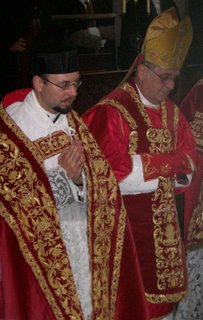 colloquium present a manifest and evident excellence in the celebration and study of the Roman liturgical
colloquium present a manifest and evident excellence in the celebration and study of the Roman liturgical 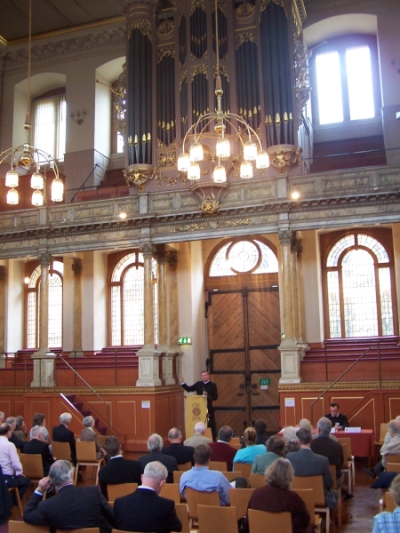 tradition."
tradition."


